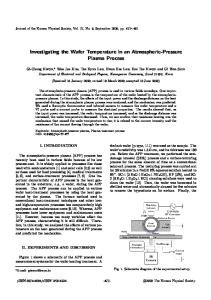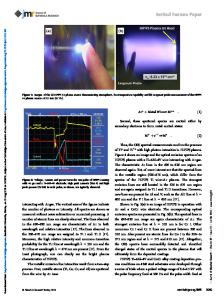Non-Conventional Atmospheric Pressure Plasma Sources for Production of Hydrogen
- PDF / 1,458,928 Bytes
- 9 Pages / 612.12 x 790.92 pts Page_size
- 90 Downloads / 341 Views
MRS Advances © 2018 Materials Research Society DOI: 10.1557/adv.2018.103
Non-Conventional Atmospheric Pressure Plasma Sources for Production of Hydrogen Hana Baránková1,2, Ladislav Bardos1,2 and Adela Bardos2 1
Uppsala University, Ångström Laboratory, Division of Electricity, Plasma Group, Box 534, SE-751 21 Uppsala, Sweden
2
BB Plasma Design AB, Ulleråkersvägen 64, SE-756 43, Uppsala, Sweden
ABSTRACT
The atmospheric pressure plasma sources with a coaxial geometry were used for generation of the radio frequency, microwave and pulsed dc plasmas inside water and aqueous solutions. Pulsed dc plasma generated in ethanol-water mixtures leads to production of the hydrogen-rich synthesis gas with hydrogen content up to 65 %. The effect of various plasma generation regimes on the performance of plasma, on the hydrogen production efficiency and on the hydrogen-rich synthesis gas production was examined. A role of the composition of the ethanol-water mixture was investigated.
INTRODUCTION Hydrogen has a great potential to be one of the most useful environment friendly source of a clean power. According to the review [1] the ability of H2 to be produced from a wide variety of feedstock by a wide variety of processes may enable all world regions to cover much of their energy needs by an own hydrogen production. The most useful sources of hydrogen are water and hydrocarbons from fossil and biomass resources. Great efforts have recently been paid to the research and development of methods of hydrogen production other than the conventional water electrolysis or the steam reforming of natural gas [2]. Among the most advanced technologies are those based on utilization of non-thermal (cold) discharge plasmas at ambient pressure [3 - 5]. Utilization of such plasmas shows very promising results [6 - 11]. Experiments have been performed for example in microwave-powered systems [9 - 11] or in dielectric barrier discharges (DBD) [3, 4]. Several reports have described also plasma assisted reforming inside liquids [6 8]. Dielectric barrier materials in contact with hydrocarbon plasma can often suffer from coatings after a long operation. In case of methane admixtures in DBD-based ozone generators depositions of sticky deposits containing carbon were reported [12]. This paper refers to an arrangement based on metal electrodes generating plasma submerged in a liquid feedstock consisting of the mixture of ethanol and water. Plasma reforming of ethanol represents an area of a great potential because bioethanol is easily accessible from biomass and also its transport is safe. Small plasma reactors powered by renewable electric power sources can then be used for production of hydrogen on demand. The first results have already confirmed very efficient production of a hydrogen-rich synthesis gas H2 + CO in this arrangement [13]. The results also indicated that the hydrogen production efficiency could even be further enhanced for optimum compositions of the mixture. Therefore, in this work, the reforming process was investigated for several
Data Loading...











